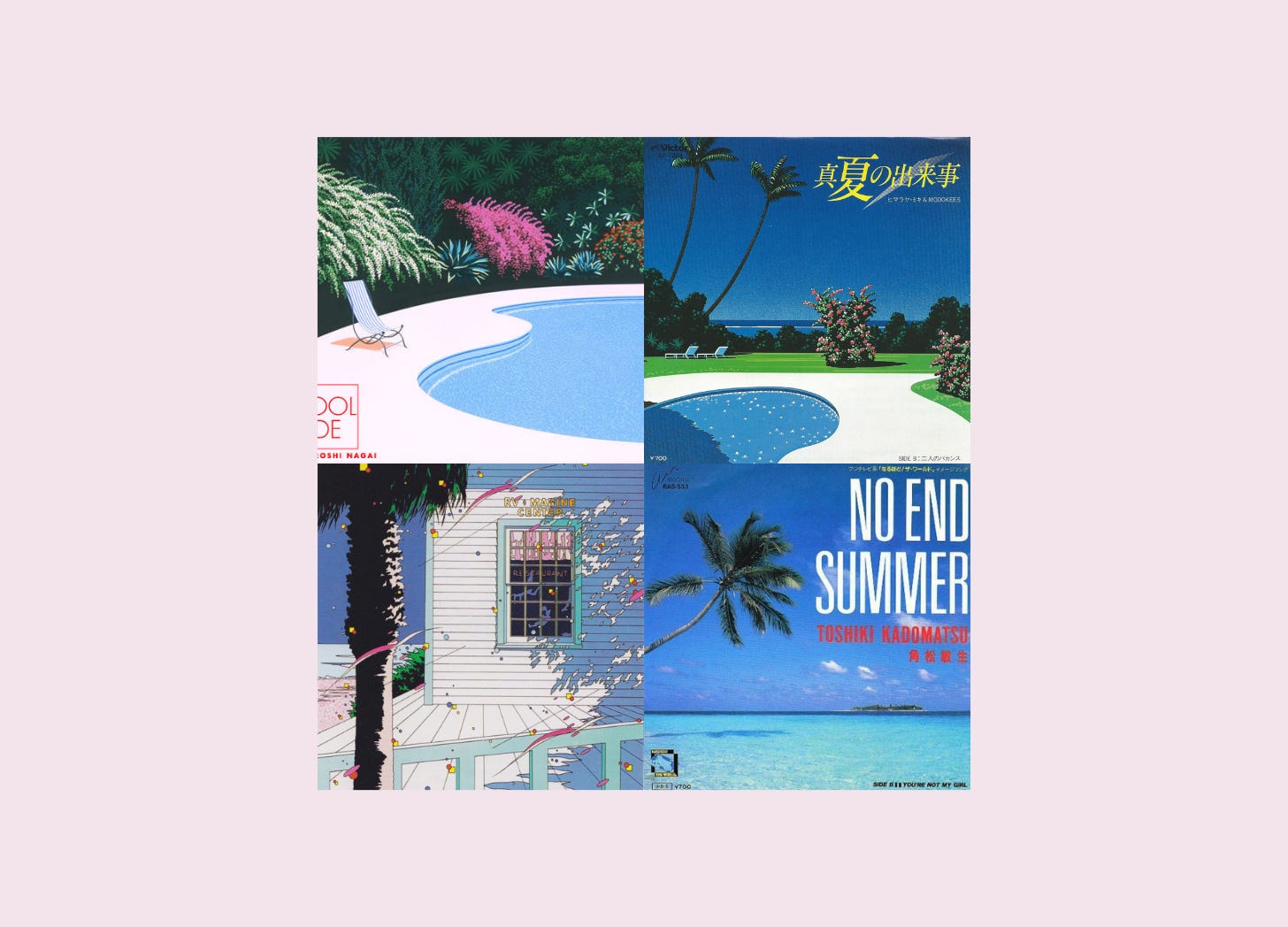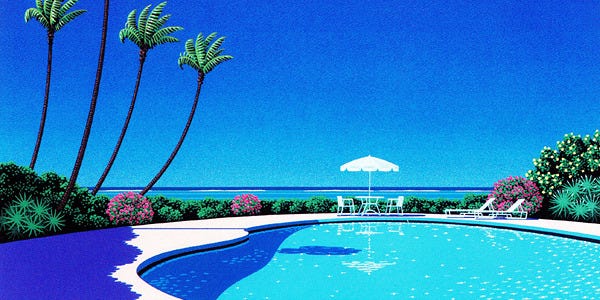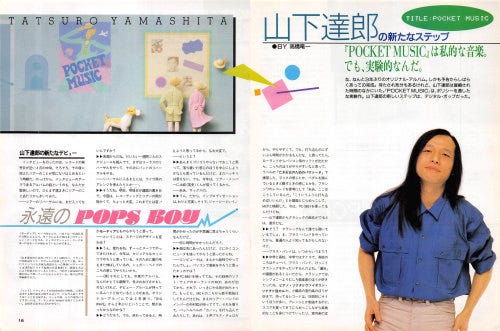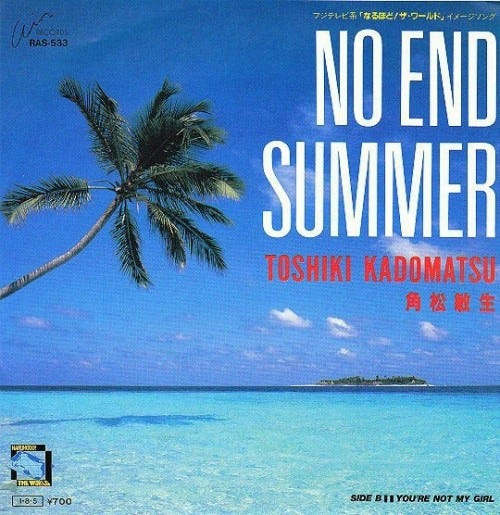Welcome to Imaginarium: an alternate history of art. A podcast where we delve in to the most obscure parts of art history.
Hello, I’m your host Nadjah, and in this podcast, we try to shed light on less studied parts of the history of art and visual culture. In today’s episode, we’re going ___ we’ll take in the sun and summer air and dive deep into the visuals and aesthetics that represents the musical genre of citypop. Let’s begin.
Citypop conjures to mind images of warm summers, lounging on the beach, dancing the night away. It conjures images of the sun, happiness. Car rides to the sunset while neon starts to light up the night.
If you don’t know what Citypop is, it’s a Japanese musical genre that mostly encompasses music from the late 70s to the early 90s but has known a huge revival lately, especially due to the rise of vaporwave music and other similar types of internet music subgenres. If you don’t know this genre, please picture this, a 45 minutes and 37 seconds youtube video, playing various “chill” 1980s Japanese pop songs while small snippets of retro anime play on repeat. If you have ever encountered this, you know exactly what I’m talking about.
You know Exactly what I'm talking about.
This is Citypop.
Citypop is a very commercial music in a lot of ways, but it’s still so filled with sincerity, happiness and hope, that it personally immediately puts me in a good mood. It's an uplifting genre that always makes me feel better when i am tired and hopeless. It’s bright and vibrant and it’s full of energy. Frankly, being in my twenties and trying to make something for myself, being exhausted and stressed and trying to maintain a balance between everything, it’s hard and sometimes you really just feel like giving up. Especially with how terribly difficult things have been in the past few years. But music in general is something that has always been a great part of my life, but Citypop specifically gives me hope that things will get better.
Tomorrow will be good.
Relaxed beats, synths, and vocals that sing of escape and of wonder, citypop reminds you of a time that’s no longer real. It’s a time that used to be and capitalizes on the nostalgia of bygone times that were once happy and prosperous, especially in a time where it’s less so in a lot of ways. Along with the rise of vaporwave, which utilizes a lot of samples and beats from citypop tracks, the rise (again) of citypop at a global level after having been (kinda) forgotten for twenty-five years can be explained by this desire to escape in a world of sun, eternal summers and shining neon lights in the night.
For all of us now, who are living in this world with a very uncertain future, in the middle of global pandemic, a climate crisis and political unease with the rise of the conservative right that’s looming all over us, especially if we are from a marginalized community. Citypop feeds a lot of nostalgia, for a time that was seemingly easier and happier. I say seemingly because we all know that no era was ever perfect, and the past is never as glossy as old magazines would lead us to believe. Nonetheless, those songs are the backdrop to a setting that seems idyllic and perfect, where nothing can go wrong, and where everyone is happy under the sun and in the warmth of an eternal summer.
The current political and social context can help explain why this genre of music has had a revival of sorts. It's a bit of a conundrum because citypop music really is the epitome of capitalistic 1980s Japan, and while i say death to capitalism, listening to this music makes me feel as if i'm walking in a busy seaside city at sunset while the neons are up and times are easy and not worrying about my future here right now in 2020.
I say revival, but I mostly mean through the mainstream consciousness both overseas and in japan, because artists who do music that’s classified as citypop continued to work well after the confines of the 80s. I can think about Toshiki Kadomatsu who kept releasing albums through the 90s and had successful 20th and 30th anniversary concerts. There are some excerpts and live performances from these concerts, and they are genuinely so fun to experience. He released an album as recently as 2018, oh how we do love to see someone still just… vibing and releasing music and having fun. He is personally one of my favorite city pop artists, and his album Sea Breeze is one of my favorites of all times, not only of the genre in itself. I do think he’s one of the most representative artists of the genre, simply with the kind of music he creates, and the aesthetic he leans in. The cover albums he uses all showcase this Citypop aesthetic and genre, from him lounging on the beach, to a neon lit city, with all the titles of his album being evocative of vacations on the beach and late summer nights.
Citypop, more than a musical genre, is very much more of an aesthetic. It has become increasingly difficult to classify which album or songs are part of citypop, the musical offering ranges from disco to synth-wave to ambient music. and so, more than just a musical genre, citypop is a mood. An atmosphere.
It’s not easy to classify what is or isn’t citypop but usually when you see it, you know it. The main visual artists who really helped cement what is the vibe and visuals of citypop are people such as Eijin Suzuki and Hiroshi Nagai. Suzuki was the artist who drew the album covers of several Tatsuro Yamashita albums. ( i will talk about him later, just know that he’s one of the flagship artists of citypop and the husband of Mariya Takeuchi who u surely know from the iconic Plastic Love song, but we’ll get to this later)
Eijin Suzuki was one of the first ones to really coin a visual aesthetic that will always remind people of citypop, his flat colors, quiet scenes with vibrant colors will become the visual blueprint of citypop aesthetic. He is an illustrator and a graphic designer who has been active since the 1980s and his art figures on prominent albums of Tatsuro Yamashita such as FOR YOU (1982), COME ALONG (1984) as well as COME ALONG II (1984). He also made his career illustrating and designing magazine covers and advertising campaigns for corporations such as Nikon, Nissan and Suntory. There’s also the 1987 collaboration of Eijin Suzuki and Tatsuro Yamashita on a compilation album and visual project called Southward Bound, with the album for the cover art also being specially made by Eijin Suzuki. Their working relationship has been going on for decades, there's even a 2002 performance advert for Yamashita that was done by Suzuki and that still holds all the elements that make his art so unique.
There's a lot of complexity in the simplicity of Suzuki's art, the colors are loud and bright, and yet, flow harmoniously together. He uses a lot of flat lays of colors, which gives his art a neatness and cleanliness that's out of this world. Too Perfect to be real. The perspective is simple and uncomplicated, and yet, the compositions of Suzuki’s art are more complex than they first appear. Suzuki’s images give the vibe of an endless summer, of bright buildings and palm trees in the distance. They fit really well in that decade of economic growth and this bright era in japan. Most importantly, Eijin Suzuki’s art is really effective at communicating a very specific mood, mellow and groovy at the same time. which is why it fits perfectly within the confines of citypop.
Hiroshi Nagai is another artist whose art and visual aesthetic will influence a lot the way we think about Citypop. Also an illustrator and a graphic designer, he has been active since the 1970s and was one of the significant visual influences on citypop. The flat colors, the bright and neon color palettes, the locations very reminiscent of summer vacations and resorts, of beaches where you can lie down and soak the sun and dip into the pool. His art is very minimalist yet vibrant, with an obvious influence from surrealism, mostly Rene Magritte, as well as pop art, one of his main influences being David Hockney and his equally as vibrants painting.
I adore Nagai’s series of paintings called poolside because that series really encapsulates a lot of what is really so lovely about citypop. The sunny cloudless skies, the vibrant colors, the clear water of the pools, the feeling of going on vacation and enjoying the warmth of the summer. Nagai also worked with a number of prominent citypop artists, which is why his art is still so emblematic of the genre. Mostly he worked on the cover art for the album A Long Vacation by Eiichi Ohtaki (which btw, i do recommend this album, if you want to listen to a bit of citypop) His art is still used today in the new citypop content as the cover art for the new compilation vinyls such Pacific Breeze: Japanese City Pop, AOR & Boogie 1976-1986, the first and second edition.
One of the important parts of citypop is its apparent westernization . Only in appearance, because it's a very Japanese way of thinking about Americana. As I said previously, citypop gained in popularity during a time of economical growth for Japan, where people started taking vacations, started going to hotels and resorts during the summer, Citypop was the background music to this entire period. It was a music that was modern, and contemporary to its generation. fun and light.
As well as visual art, photography and the pastel colors and the neon and the ~vibes~ like i do not want to be that person, but citypop is really that hard to pin, mostly because it relies on the Vibes the art and music gives off, more than it pertains to a specific musical or artistic genre. Whether it's the beaches, the pastel and neon colors, the urban landscapes or resort backgrounds, the contrasting colors, those elements are often found in almost all of the album covers or the visual material that surrounds citypop.
Citypop, as a genre, started during the late 1970s. But then, it wasn’t really known as citypop yet, it was a term that was later coined to designate urban pop music from the city, aka citypop. The early pioneers of the genre were Haruomi Hosono and Ryuichi Sakamoto when they were still part of the band Yellow Magic Orchestra. They experimented with synth sounds and had a western influence to their music that made what they created completely new but as Hosono says it, the sounds that they were creating were very different from their western contemporaries, because “For us, those tools are not just objects. Japanese people can feel some attachment in what they are making, whether it is a car or a TV or a computer.” And they did use those new tools, those new computers and new electric sounds. As much as citypop today is a synonym of nostalgia and bygone days, it used to be contemporary and current. It was a symbol of those times. that they were living through. A symbol of youth and of modernity.
(side-note, if anyone is curious, there’s this documentary on youtube called Tokyo melody that documents Ryuichi Sakomoto’s career in the early 80s and just how experimental and innovative they were, you can watch it HERE)
A lot of artists made citypop what it is, but i don't think we can talk about City pop without first mentioning Tatsuro Yamashita and Mariya Takeuchi. The power couple of citypop. His debut album, Big Wave is a cover album of beach boys with a very bright feeling (btw let me just brag that i own this on vinyl and it's a brilliant album)
Yamashita was one of the most prolific and well known artists of the genre, as well as being a musical artist himself with albums such as Ride On Time, or Spacy. He also produced a lot of movies and worked with a lot of different artists on different projects.
A lot of what citypop is, musically speaking, is born out of the western musical influence, think the beach boys, Bob Dylan, etc. mostly folk and pop music of the 1960s and the 1970s. But the artists took those inspirations and really spun them around as well as exploring the new tools for making music that they had at their disposal. so it made for a fresh and new sound. There’s also a direct inspiration from the music known as soft or sunshine pop, or the southern Californian music of the 1960s, that is obviously carried onto the 1980s citypop aesthetic of summer.
Citypop had a lot of exploration of the musical medium, a lot of instrumental albums as well as collaborations between various artists such as the album PACIFIC by Haruomi Hosono, Shigeru Suzuki and Tatsuro Yamashita . Citypop went in various direction, you have toshiki kadomatsu and tatsuro yamashita who compose and sing on their albums, you also have Sugiyama Kiyotaka & Omega Tribe who really went all the way into the experimental instrumental side of citypop that was more about the Ambient music rather than sung tracks. As for the ambient instrumental side of things, we can name albums such as PACIFIC by Haruomi Hosono, Shigeru Suzuki and Tatsuro Yamashita or the series of albums that was the Sound Image Series. That series had albums such as The Aegean Sea or New York. It was meant to be an ambient listen that captured the atmosphere of that specific place.
City pop inherently feels like a soundtrack for the virtual age today, with vaporwave artists such as YUNG BAE or NIGHT TEMPO sampling those tracks and making a blend of the past and the future. Those songs seem dreamy and otherworldly. Vaguely ethereal and fake, something that you might have heard through an old radio while you were on vacation for the first time with your family at age 7. The spread of citypop today is very much an effect of the internet age, specially with the tracks that end on youtube, the lo-fi mixes and the youtube algorithm putting PLASTIC LOVE - MARIYA TAKEUCHI on everyone’s feed. I’ll also link this video in the show-notes. Released in 1984, in the midst of when citypop was booming, This song, I feel, is the one that truly put citypop on the general consciousness of people. It’s a song that is now representative of the sound that is citypop. The genre was always there and people have been continuously listening to that music, but it truly feels like it’s at that moment that people became more aware of it. This track presently has 33M views on youtube, on the day of recording, and I feel that the internet truly is one of the main reasons why this genre is so well known today.
And visually, that one picture of Mariya Takeuchi is also one of the easily recognizable symbols of citypop.
Today, the classic albums of citypop have known a resurgence, there have been multiple reprints of staple city pop vinyls and some labels have even been publishing mixes like TOKYO NIGHTS : FEMALE BOOGIE FUNK : FROM 1981 TO 1988, (which btw i have had my eyes on this for a while…) and the visuals that were once the hallmark of 80s Japanese music, have came back in force especially in the future funk-vaporwave-lofi-etc etc music subgenres that have been getting really popular. I mentioned Night Tempo earlier, he’s a south Korean musical artist who often works within the confines of the future funk genre: a genre that is known for the retro vibes and throwbacks to 80s songs and aesthetics, as well as older 80s and 90s anime. He works with visual artists such as Namu13 (which translates to Tree13) (https://www.instagram.com/__tree_13/) and Shiho So (https://www.instagram.com/shihoso/) who create for him a very fresh and yet nostalgic aesthetic for his albums and tracks.
The work of Shiho So is very heavily inspired by anime such as Sailor Moon as well as Ranma 1-2 by Rumi Takahashi, which is very obvious in the way she approaches her illustration and the color scheme she chooses. The images she creates are always very soft and cute. When it comes to Namu13’s work, it’s also very much retro inspired as well, from the early 80s to the mid 90s. He takes inspiration from animation movies and comics and he really works in a manner that makes you feel a sort of nostalgia for that era. He tries to capture the aesthetic of 80s tapes and vinyls, in a manner that feels new yet old. His work is directly inspired by Eijin Suzuki and Hiroi Nagashi’s work as well as artists such Yamane Yoshitake whose art is, in my opinion, a bridge between the citypop art and the manga style of that era. These artists often use the same sort of color schemes, neons and pastels, very bright images, but you can also see the incorporation of visual elements such as grids and flat colors.
Inspired by those 80s anime and citypop albums, those artists have managed to create a brand new sound and a brand new image, that still is cohesive. Future funk is a music that you can dance to and have fun listening to. Night Tempo sometimes even releases his music on tapes or vinyls, so there’s that added fun vintage and retro touch to it. The images and the music of future funk, as well as the original Japanese city pop music along with the original images, work in a perfect tuned relationship. Of course you can listen to that music without caring for those visual aesthetics, or appreciate those images on their own without wanting to listen to the music. But I think it’s very fascinating how they truly go hand in hand and complete each other.
More than simple nostalgia, the dreamy ethereal feeling of citypop and future funk provide to its listeners a sense of wonder and escapism, because as artist F*kaori explains when asked about why people love to immerse themselves in this 80s nostalgia dream, “reality is painful”. Life is hard, life is so difficult, and we really just are trying our best to be happy, to make something of ourselves, to live and achieve our dreams. And I think it’s worth having something that makes you feel some kind of joy, a respite from everything that’s happening. These songs are energizing and hopeful, dreamy and relaxing. I just personally really enjoy listening to that music and, even though i cannot necessarily spend two months of vacation in a very cute adorable coastal city, i can at least have this.
Hopefully people can continue to feel a sense of nostalgia and escape while listening to that music, and on this note, I think it’s time to end the episode here.
Before we go, I put a bunch of relevant resources on today’s subject in the show notes, you have some books as well as some theses and articles that you can read if you maybe want to further your knowledge and read more on the subject. I also linked a youtube list with my favorite citypop tracks over on my patreon. As always, all the relevant images will also be on all of our social platforms @ imaginarium_pod on instagram as well as on twitter. If you want to support this podcast, you can do so on patreon @ ____ or if you just want to support punctually, you can also do so on ko-fi @ ____ . Rating and reviewing this podcast always helps as well. Thank you for sticking with me and today’s recommendation is the song “it’s hard to say goodbye” by toshiki kadomatsu + Yurie Kokobu. On this, my very dear listeners, I wish you all a very lovely day, evening or night. and hopefully i will see you again very soon.
BIBLIOGRAPHY :
ARCAND, Rob & GOLDNER, Sam. The Guide to Getting Into City Pop, Tokyo’s Lush 80s Nightlife Soundtrack
<https://www.vice.com/en_us/article/mbzabv/city-pop-guide-history-interview>
BLISTEIN, Jon. City Pop: Why Does the Soundtrack to Tokyo’s Tech Boom Still Resonate? <https://www.rollingstone.com/music/music-features/japanese-city-pop-returns-light-in-the-attic-compilation-pacific-breeze-822663>
HELFET, Gabriela. The women of Japan’s ’80s City Pop scene collected on new compilation
<https://thevinylfactory.com/news/tokyo-nights-compilation/>
SCHOOP, E. City Pop: The Internet’s Lost Genre. <https://boredkids.tumblr.com/post/158690587145/city-pop-the-internets-lost-genre-by-e-schoop>
가장 트렌디한 80~90년대 감성! 아이패드에서 그렸다고? : 레트로 일러스트레이터, 나무13 (ENG/KOR/JPN sub)
Vaporwave to Future Funk: Night Tempo artists on the aesthetics of City Pop - Features
City Pop Is the 40-Year-Old Genre You've Never Heard of, Until Today









